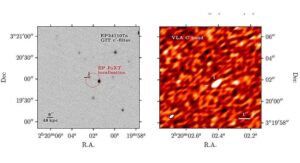
Multicolored chemical 3D molecules, bubbles, drops on blue, purple background.
Physicists have successfully examined the magnetism within the nucleus of a molecule, marking a significant breakthrough in the field of nuclear physics. In a study published on October 23, 2023, in the journal Science, researchers from CERN and the Massachusetts Institute of Technology (MIT) investigated a rare radioactive molecule known as radium monofluoride (RaF). This research represents the first observation of how magnetism is distributed within a molecule’s nucleus, revealing insights that could challenge existing theories in physics.
Exploring the Unseen: The RaF Molecule
The RaF molecule consists of a radium atom and a fluoride atom, each possessing its own nucleus. The radium nucleus exhibits a unique characteristic referred to as “octupole deformation,” which means it has an irregular shape, likened to that of a pear or avocado, according to Shane Wilkins, a physicist at MIT and the study’s lead author. This atypical shape makes RaF an ideal candidate for detecting asymmetries that could provide clues to the underlying principles governing the universe.
Researchers believe that the distribution of protons and neutrons within radioactive nuclei can amplify subtle breaks in symmetry. According to Silviu-Marian Udrescu, a co-author of the study from MIT, identifying these small asymmetries may lead to groundbreaking discoveries beyond the current Standard Model of particle physics.
Methodology and Findings
The team created radium monofluoride at CERN’s ISOLDE facility by bombarding a uranium target with high-energy protons, which produced the rare isotope radium-225. This isotope was then combined with fluorine gas to form the RaF molecule, which existed for only fractions of a second, making measurements challenging. The scientists managed to detect approximately fifty RaF molecules per second in a stable state suitable for analysis.
To investigate the internal structure of RaF, the researchers directed multiple laser beams of slightly varying frequencies at the molecules. By examining the light absorbed or emitted by the molecules, they were able to produce a spectrum that revealed significant insights. Traditionally, such patterns provide information about electron movements around the nucleus, but in this instance, shifts in the spectrum indicated that the electrons were influenced by the properties of the radium nucleus itself.
Wilkins emphasized the importance of this discovery, stating, “The electron actually probes inside the nucleus, so you can no longer treat it as a long-range interaction. Instead, it starts to sense the internal properties of the radium nucleus itself.” This phenomenon, termed the Bohr–Weisskopf effect, had not previously been observed in a molecular context.
The researchers’ findings suggest that these molecules could be powerful tools for conducting precision measurements that explore fundamental questions in physics. As a next step, the team plans to slow and trap RaF molecules with lasers, allowing for even more detailed investigations of potential asymmetries in nature.
Udrescu remarked, “Now we know they can be powerful tools to look for new physics,” highlighting the potential for future research to unlock further mysteries of the universe.






